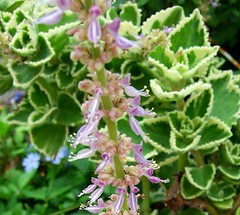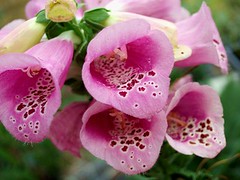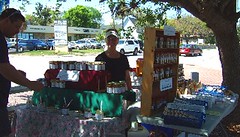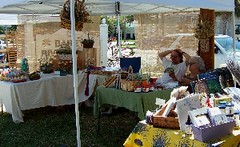On March 31 and April 1, I took my herbs and a few herbal books and other goodies to the 7th Annual Spring Fever in the Garden in historic downtown Winter Garden. This garden show was put on by the Bloom N Grow Garden Society whose members could not have been more helpful and accommodating. They also attracted a good crowd, all of which meant I not only had a good show saleswise, but had fun doing the show, too. They have a
website for the Spring Fever which is really spectacular.

I love a good historic downtown area and Winter Garden has a very nice one. Lots of little restaurants, including the Moon Cricket Grille across from my booth with an owner who traded me a lunch for some herbs.
The show took place, appropriately enough, on Plant Street, a brick street with

a beautiful island down the middle and places like

the Garden Theater which welcomed the show.
I was fortunate to be near one of the performers, singer
Grant Livingston, who kept me entertained both days with his humorous songs.



My booth was filled mostly with herbs and I tried to bring a good selection of the favorites that everyone wants along with a few unusual things to delight those herb gardeners seeking something different. The biggest hit seemed to be the tray of nasturtiums.
I also brought a few herb books, some herbal gadgets (like herb keepers and mortars and pestles), a few of my Provence crafts and some great vintage wooden herb carriers.
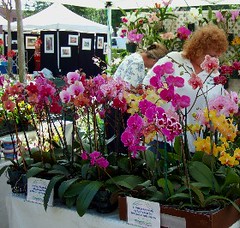
Of course, no garden show would be complete without orchids

or roses and there were many other plant booths, too, although I wasn't able to get away from my booth for very long to take pictures of them all.
Being a potter myself, I was especially interested in several booths that had ceramics:

I've been designing several plant labels including some with herb names in French to coincide with my Herbes de Provence store theme. This artist had several very cute ceramic labels (some with French herb names!) although they're much different than the ones I'm planning. I even made a trade here.

This artist makes large funky brightly-colored ceramic sculptures for the garden including totem-like stakes and a working fountain.
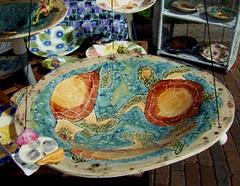

I love this potter's great birdbaths with painted and three-dimensional flowers, turtles and frogs.
Really, the ceramic stuff was terrific and would brighten up any garden.
Also brightening up a garden would be any of the adirondak chairs that were up for (silent) auction:


including my favorite:














